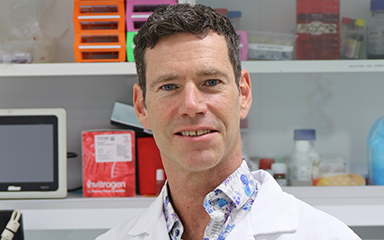Cell Signalling
Associate Professor Evan Ingley

Cell Signalling
Associate Professor Evan Ingley
Profile
Associate Professor Evan Ingley BSc(Hons), PhD heads the Cell Signalling group, which has an interest in understanding the signalling networks or “information highways” of both normal and diseased cells. Evan’s Honours degree at the University of Canterbury (New Zealand) included a research project on the hormonal control of genes important for cockroach reproduction but developed an interest in understanding molecular interactions involved in cancer/leukaemia. Evan completed his PhD at The Australian National University in the John Curtin School of Medical Research (Canberra) under the direction of Professor Ian Young, working on the interaction between the cytokine Interleukin-5 (IL-5) and its receptor. For his postdoctoral studies he moved to Switzerland working with Dr Brian Hemmings at the Friedrich Miescher Institute, the flagship research institute of the pharmaceutical company Novartis. Dr Hemmings had recently identified the new oncogene Akt/PKB and Evan worked on its regulation through protein-protein as well as protein-lipid interactions. On returning to Australia Evan began using his expertise on protein-protein interactions involved in signal transduction to uncover novel pathways involved in red blood cell development and lineage determination. After his discovery of the importance of Lyn in erythropoiesis he began establishing a focus on the signalling pathways of this molecule and set up the Cell Signalling Group.
Research Overview
Currently his research group is analysing the biological and signalling consequences of alterations to Lyn-regulated pathways in sarcoma metastasis (the AFAP1L1-pathway) and red blood cell longevity/integrity. Additionally he is working on precision genomic medicine for sarcoma patients and collaborates on projects looking at cardiovascular disease as well as on drug sensitivity in patients.
Associate Professor Ingley was the inaugural ‘Sock it to Sarcoma! Senior Research Fellow’ and his research is significantly supported by Sock it to Sarcoma!
Research Projects
- The control of sarcoma cell metastasis through the novel AFAP1L1 pathway.
- The control of red blood cell longevity and integrity through Lyn/Src Family Kinase pathways.
- Identifying new therapy options for sarcoma patients through personalized genomic medicine.
- Studying the magnitude of the effect of enzyme variations on the ability of young cancer patients to handle High-Dose-Methotrexate (HDMTX) treatment, as HDMTX can causes severe toxicities.
- Using personalized genomic medicine to identify potential new therapeutic potions for sarcoma patients.
Selected Publications
1. Maira S-M, Galetic I, Brazil DP, Kaech S, Ingley E, Thelen M, Hemmings BA. 2001. Carboxyl-terminal modulator protein (CTMP), a negative regulator of PKB/Akt and v-Akt at the plasma membrane. Science 294:374-80. [NCBI PubMed Entry]
2. Ingley E, McCarthy DJ, Pore, JR, Sarna MK, Adenan AS, Wright MJ, Erber W, Tilbrook PA, Klinken SP. 2005. Lyn deficiency reduces GATA-1, EKLF and STAT5, and induces extramedullary stress erythropoiesis. Oncogene 24:336-43. [NCBI PubMed Entry]
3. Ingley E, Schneider JR, McCarthy DJ, Harder KW, Hibbs ML, Klinken SP. 2006. Csk-binding protein mediates sequential enzymatic down-regulation and degradation of Lyn in erythropoietin-stimulated cells. Journal of Biological Chemistry 281:31920-9. [NCBI PubMed Entry]
4. Frech M, Andjelkovic M, Ingley E, Reddy KK, Falck JR, Hemmings BA. 1997. High affinity binding of inositol phosphates and phospholipids to the pleckstrin homology domain of RAC / protein kinase B and their influence on kinase activity. Journal of Biological Chemistry 272:8474-81. [NCBI PubMed Entry]
5. Tilbrook PA, Ingley E, Williams JH, Hibbs ML, Klinken SP. 1997. Lyn tyrosine kinase is essential for erythropoietin-induced differentiation of J2E erythroid cells. EMBO Journal 16:1610-9. [NCBI PubMed Entry]
6. Williams NK, Lucet IS, Klinken SP, Ingley E, Rossjohn J. 2009. Crystal structures of the Lyn protein tyrosine kinase domain in its Apo- and inhibitor-bound state. Journal of Biological Chemistry 284:284-291.[NCBI PubMed Entry]
7. Calvert N, Wu J, Sneddon S, Woodhouse J, Carey-Smith R, Wood D, Ingley E. 2018. The use of whole exome sequencing and murine patient derived xenografts as a method of chemosensitivity testing in sarcoma. Clinical Sarcoma Research 8:e4(1-8).https://www.ncbi.nlm.nih.gov/pubmed/29541442
8. Kendrick TS, Payne CJ, Epis MR, Schneider JR, Leedman PJ, Klinken SP. Ingley E. 2008. Erythroid defects in TRα-/- mice. Blood 111:3245-3248.[NCBI PubMed Entry]
9. Samuels AS, Klinken SP, Ingley E. 2008. Liar, a novel Lyn-binding nuclear/cytoplasmic shuttling protein that influences erythropoietin-induced differentiation. Blood 113:3845-56. [NCBI PubMed Entry]
10. Slavova-Azmanova NS, Kucera N, Satiaputra J, Stone L, Magno M, Maxwell MJ, Quilici C, Erber W, Klinken SP, Hibbs ML, Ingley E. 2013. Gain-of-function Lyn induces anemia – appropriate Lyn activity is essential for normal erythropoiesis and Epo-receptor signaling. Blood 122:262-271.[NCBI PubMed Entry]
